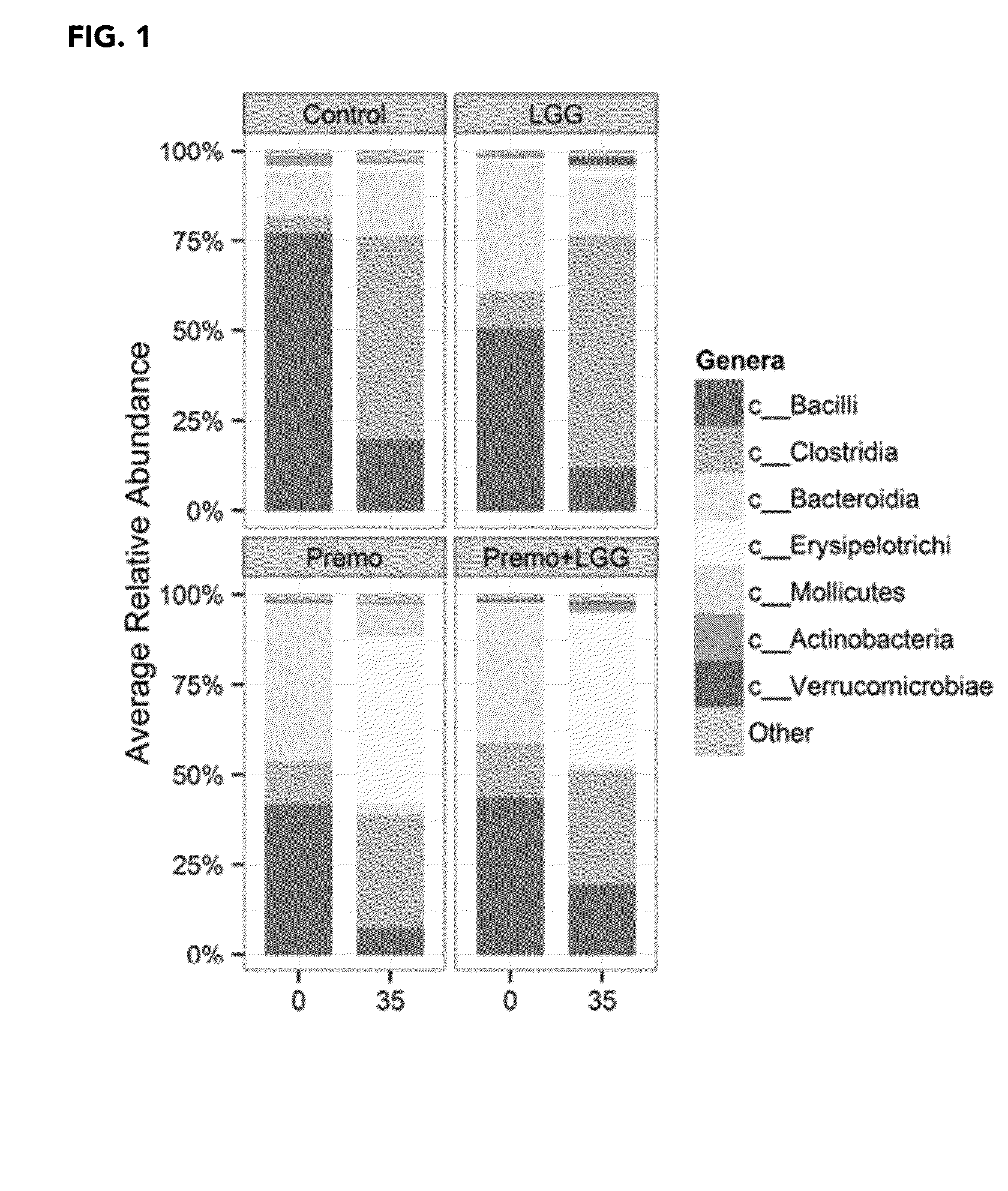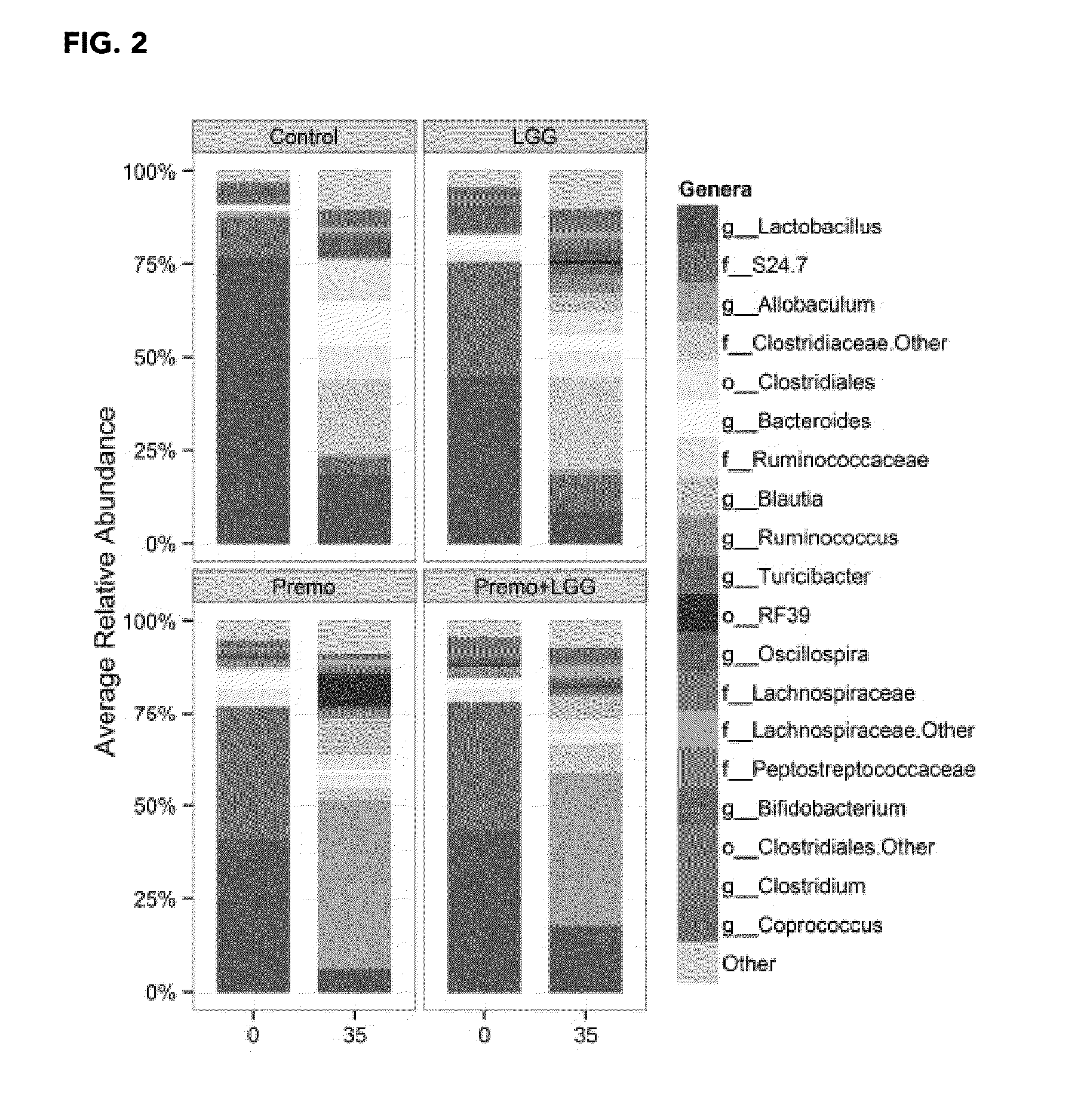Methods of use for probiotics and prebiotics
a probiotic and prebiotic technology, applied in the field of probiotics and prebiotics, can solve the problems of abnormal development, low pain thresholds later in life, long-term visceral hypersensitivity observed during childhood, etc., to reduce the incidence of visceral hyperalgesia, reduce the risk of visceral pain hypersensitivity, and reduce the incidence of fap
- Summary
- Abstract
- Description
- Claims
- Application Information
AI Technical Summary
Benefits of technology
Problems solved by technology
Method used
Image
Examples
example 1
[0113]Example 1 describes the microbiome changes in fecal matter of laboratory rats fed diets of PDX and GOS, LGG, and both PDX, GOS, and LGG as compared to a control.
[0114]Briefly, weanling (postnatal day 21) Long Evans (LE) rats were fed control or PDX / GOS diet chow (GOS 7 g / kg+PDX 7 g / kg) for four weeks. Probiotic LGG was reconstituted at a concentration of 1×108 CFU / ml in drinking water. Each cage received between 80-150 mL each day depending on size and number of animals per cage. Each rat was randomly assigned across the treatment groups. Animals were maintained on a 12 / 12 light / dark cycles. The memory test, assessed using the time-dependent version of novel object recognition, was performed during the animal's light cycle phase. Body weights were taken three times a week for the duration of the study. Observations of any clinical signs of illness were noted. Food consumption was measured every other day for the duration of the study. Fecal samples were collected at three time...
example 2
[0126]This example describes the effect of LGG on the neurotransmitter levels in the brain. Briefly, chronic visceral hyperalgesia was induced in rats by administration of intracolonic zymosan (or normal saline for control) for three consecutive days during postnatal day 14-16 (P14-P16). LGG treatment was initiated after weaning (P21) and continued until P60. The levels of neurotransmitters and amino acids were quantified in the frontal cortex, sub-cortex, brain stem and cerebellum.
[0127]The quantitative assessment of neurotransmitters was conducted using HPLC-based separation followed by fluorescent and / or electrochemical detection. Briefly, brain sections were homogenized, using a tissue dismembrator, in 100-750 ul of 0.1 M TCA, which contains 10-2 M sodium acetate, 10-4 M EDTA, 5 ng / ml isoproterenol (as internal standard) and 10.5% methanol (pH 3.8). Samples were spun in a microcentrifuge at 10000 g for 20 minutes. Samples of the supernatant were then analyzed for neurotransmitte...
example 3
[0131]Example 3 shows the efficacy of LGG treatment in reducing visceral pain sensitivity.
[0132]Example 3 utilized a rat colonic zymosan-treated hyperalgesia model (i.e. a model of post-inflammatory visceral pain sensitivity). Zymosan was injected into the colon during the neonatal period producing short-term inflammation and subsequent long-term colonic hypersensitivity. The data demonstrated that LGG attenuated visceral hypersensitivity.
[0133]As can be seen in FIG. 7, neonatal intra-colonic zymosan instillation produced visceral hyperalgesia in adult rats as observed by significant increase in viscera-motor response (VMR) as compared to colorectal distension (CRD) compared to intra-colonic saline-treated rats (Control). As can be further seen in FIG. 7, treatment with LGG significantly attenuated the viscera-motor response. Thus, as shown in FIG. 7, LGG, GOS, and PDX had a significant visceral analgesic effect in zymosan-induced colitis. The introduction of zymosan produced viscer...
PUM
 Login to View More
Login to View More Abstract
Description
Claims
Application Information
 Login to View More
Login to View More - R&D
- Intellectual Property
- Life Sciences
- Materials
- Tech Scout
- Unparalleled Data Quality
- Higher Quality Content
- 60% Fewer Hallucinations
Browse by: Latest US Patents, China's latest patents, Technical Efficacy Thesaurus, Application Domain, Technology Topic, Popular Technical Reports.
© 2025 PatSnap. All rights reserved.Legal|Privacy policy|Modern Slavery Act Transparency Statement|Sitemap|About US| Contact US: help@patsnap.com



